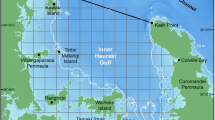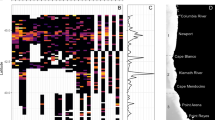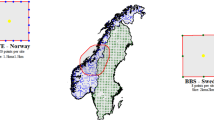Abstract
To develop appropriate spatial conservation planning for individual species, it is important to understand their habitat requirements and in particular to identify areas where critical life-history process such as breeding, weaning or feeding take place. The process of defining critical habitat often ignores behavioural aspects of animal distribution, which for highly migratory species like baleen whales whose feeding and breeding grounds are clearly demarcated and widely separated is not a problem. However, for other species like the endangered ‘Eastern North Pacific southern resident’ killer whale stock, critical life-history processes occur in the same waters. This killer whale stock lives in a topographically complex region (many islands) off the west coast of Canada/USA, which makes accurate mapping of densities or behaviours difficult using traditional generalised additive models. We present results on the spatial distribution of southern resident killer whale feeding grounds in 2006, using a binomial, complex region spatial smoothing model within a generalised estimating equation framework, which allows for both complex topography and correlated residuals. The model performs well and suggests a region to the south of San Juan Island as an area with a high probability of feeding, which could not have been as accurately established from a more traditional presence–absence model. We also calculate estimates of precision, which other studies did not include, enabling more informed management decisions for spatial conservation planning. A vignette containing the code along with an R workspace and function file is provided to allow the user to fit the models presented in this paper.
Supplementary materials accompanying this paper appear on-line.




Similar content being viewed by others
References
Agresti, A. (2002), Categorical Data Analysis, 2\(^{nd}\) edn John Wiley & Sons Inc.
Araújo, M., and Guisan, A. (2006) , “Five (or so) challenges for species distribution modelling,” Journal of Biogeography, 33, 1677–1688.
Ashe, E., Noren, D., and Williams, R. (2010), “Animal behaviour and marine protected areas: incorporating behavioural data into the selection of marine protected areas for an endangered killer whale population,” Animal Conservation, 13(2), 196–203.
Belotti, E., Kreisinger, J., Romportl, D., Heurich, M., and Bufka, L. (2014), “Eurasian lynx hunting red deer: is there an influence of a winter enclosure system?,” European Journal of Wildlife Research, 60(3), 441–457.
Brown, H., and Prescott, R. (2006), Applied mixed models in medicine, John Wiley & Sons Inc.
Buckland, S. T., Burnham, K. P., and Augustin, N. H. ( 1997), “Model Selection: An Integral Part of Inference,” Biometrics, 53, 603–618.
Burnham, K. P., and Anderson, D. R. ( 2004), “Multimodel Inference: Understanding AIC and BIC in model selection,” Sociological methods & research, 33(2), 261–304.
Burnham, K. P., and Anderson, D. R. ( 2010), Model Selection and Multimodel Inference: A practical information-theoretic approach, 2\(^{nd}\) edn Springer.
Camphuysen, K. C., Shamoun-Baranes, J., Bouten, W., and Garthe, S. (2012), “Identifying ecologically important marine areas for seabirds using behavioural information in combination with distribution patterns,” Biological Conservation, 156, 22–29.
Cramer, J. (2003), Logit models: from economics and other fields, Cambridge University Press.
Floyd, R. W. (1962), “Algorithm 97: Shortest path,” Communications of the ACM, 5, 345.
Gerrodette, T., and Eguchi, T. (2011), “Precautionary design of a marine protected area based on a habitat model,” Endangered Species Research, 15(2), 159–166.
Goetz, K. T., Montgomery, R. A., Hoef, J. M., Hobbs, R. C., and Johnson, D. S. (2012), “Identifying essential summer habitat of the endangered beluga whale Delphinapterus leucas in Cook Inlet, Alaska,” Endangered Species Research, 16(2), 135–147.
Halekoh, U., Hojsgaard, S., and Yan, J. ( 2006), “The R package geepack for Generalized Estimating Equations,” Journal of Statistical Software, 15(2).
Halpern, B. S., Walbridge, S., Selkoe, K. A., Kappel, C. V., Micheli, F., D’Agrosa, C., Bruno, J. F., Casey, K. S., Ebert, C., Fox, H. E. et al. (2008), “A global map of human impact on marine ecosystems,” Science, 319(5865), 948–952.
Hansen, M. . H., and Kooperberg, C. ( 2002), “Spline Adaptation in Extended Linear Models, Statistical Science,” 17, 2–51.
Hardin, J., and Hilbe, J. (2002), Generalized Estimating Equations, Chapman & Hall/CRC.
Hastie, T. J., and Tibshirani, R. J. ( 1990), Generalized Additive Models, Chapman & Hall.
Hauser, D., Logsdon, M., Holmes, E., VanBlaricom, G., and Osborne, R. (2007), “Summer distribution patterns of southern resident killer whales Orcinus orca: core areas and spatial segregation of social groups,” Marine Ecology Progress Series, 351, 301–310.
Hawkins, B. (2012), “Eight (and a half) deadly sins of spatial analysis,” Journal of Biogeography, 39, 1–9.
Hedley, S. L., and Buckland, S. T. ( 2004), “Spatial models for line transect sampling,” Journal of Agricultural, Biological, and Environmental Statistics, 9(2), 181–199.
Heithaus, M., Dill, L., Marshall, G., and Buhleier, B. (2002), “Habitat use and foraging behavior of tiger sharks (Galeocerdo cuvier) in a seagrass ecosystem,” Marine Biology, 140(2), 237–248.
Hosmer, D., and Lemeshow, S. (1989), “Logistic regression for matched case-control studies,” Applied logistic regression, 2, 223–259.
Jang, D., and Oh, H.-S. (2011), “Enhancement of spatially adaptive smoothing splines via parameterization of smoothing parameters,” Computational Statistics and Data Analysis, 55, 1029–1040.
John, P. W. M., Johnson, M. E., Moore, L. M., and Ylvisaker, D. (1995), “Minimax distance designs in two-level factorial experiments,” Journal of Statistical Planning and Inference, 44, 249–263.
Jonsen, I. D., Myers, R. A., and James, M. C. ( 2007), “Identifying leatherback turtle foraging behaviour from satellite telemetry using a switching state-space model,” Marine Ecology Progress Series, 337, 255–264.
Kaschner, K., Quick, N. J., Jewell, R., Williams, R., and Harris, C. M. (2012), “Global coverage of cetacean line-transect surveys: status quo, data gaps and future challenges,” PloS one, 7(9).
Krivobokova, T., Crainiceanu, C. M., and Kauermann, G. (2008), “Fast Adaptive Penalized Splines,” Journal of Computational and Graphical Statistics, 17(1), 1–20.
Lascelles, B. G., Langham, G. M., Ronconi, R. A., and Reid, J. B. (2012), “From hotspots to site protection: Identifying Marine Protected Areas for seabirds around the globe,” Biological Conservation, 156, 5–14.
Liu, C., Berry, P., Dawson, T., and Pearson, R. ( 2005), “Selecting thresholds of occurrence in the prediction of species distributions,” Ecography, 28, 385–393.
Ludwig, D., Hilborn, R., and Walters, C. ( 1993), “Uncertainty, resource exploitation, and conservation: lessons from history,” Science, 260(5104), 17–36.
Lusseau, D., Bain, D., Williams, R., and Smith, J. ( 2009), “Vessel traffic distupts the foraging behaviour of southern resident killer whales Orcinus orca,” Endangered Species Research, 6, 211–221.
Lusseau, D., Williams, R., Wilson, B., Grellier, K., Barton, T. R., Hammond, P. S., and Thompson, P. M. (2004), “Parallel influence of climate on the behaviour of Pacific killer whales and Atlantic bottlenose dolphins,” Ecology Letters, 7(11), 1068–1076.
Mann, J. (1999), “Behavioural Sampling Methods for Cetaceans: A Review and Critique,” Marine Mammal Science, 15(1), 102–122.
NMFS (2008), “Recovery plan for Southern Resident Killer Wales (Orcinus orca).,” in Federal Register, Vol. 251, Seattle, WA, USA, National Marine Fisheries Service, Northwest Region.: National Marine Fisheries Service, pp. 20870–20890.
Noss, R. F., Quigley, H. B., Hornocker, M. G., Merrill, T., and Paquet, P. C. (1996), “Conservation biology and carnivore conservation in the Rocky Mountains,” Conservation Biology, 10(4), 949–963.
O’Leary, B., Brown, R., Johnson, D., Von Nordheim, H., Ardron, J., Packeiser, T., and Roberts, C. (2012), “The first network of marine protected areas (MPAs) in the high seas: the process, the challenges and where next,” Marine Policy, 36(3), 598–605.
Pan, W. (2001a), “Akaikes’s Information Criterion in Generalized Estimating Equations,” Biometrics, 57(1), 120–125.
Pan, W. (2001b), “Model Selection in Estimating Equations,” Biometrics, 57, 529–534.
Panigada, S., Zanardelli, M., MacKenzie, M., Donovan, C., Melin, F., and Hammond, P. (2008), “Modelling habitat preferences for fin whales and striped dolphins in the Pelagos Sanctuary (Western Mediterranean Sea) with physiographic and remote sensing variables,” Remote Sensing of Environment, 112(8), 3400–3412.
Pearce, J., and Ferrier, S. (2000), “Evaluating the predictive performance of habitat models developed using logistic regression,” Ecological Modelling, 133, 225–245.
Priotta, E., Matthiopoulos, J., Mackenzie, M., Scott-Hayward, L. A. S., and Rendell, L. (2011), “Modelling sperm whale habitat preference: a novel approach combining transect and follow data,” Marine Ecology Progress Series, 436, 257–272.
R Core Team (2013), R: A Language and Environment for Statistical Computing, R Foundation for Statistical Computing, Vienna, Austria.
Ramsay, T. O. (2002), “Spline smoothing over difficult regions,” Journal of the Royal Statistical Society: Series B (Statistical Methodology), 64(1), 307–319.
Redfern, J., Ferguson, M., Becker, E., Hyrenbach, K., Good, C. P., Barlow, J., Kaschner, K., Baumgartner, M. F., Forney, K., Ballance, L. et al. (2006), “Techniques for cetacean-habitat modeling,” Marine Ecology Progress Series, 310, 271–295.
Richards, S. A. (2008), “Dealing with overdispersed count data in applied ecology,” Journal of Applied Ecology, 45(1), 218–227.
Scott-Hayward, L. A. S., Mackenzie, M. L., Donovan, C. R., Walker, C. G., and Ashe, E. (2014), “Complex Region Spatial Smoother (CReSS),” Journal of Computational and Graphical Statistics, 23(2), 340–360.
Tepsich, P., Rosso, M., Halpin, P. N., and Moulins, A. (2014), “Habitat preferences of two deep-diving cetacean species in the northern Ligurian Sea,” Marine Ecology Progress Series, 508, 247–260.
Vaz, S., Martin, C. S., Eastwood, P. D., Ernande, B., Carpentier, A., Meaden, G. J., and Coppin, F. (2008), “Modelling species distributions using regression quantiles,” Journal of Applied Ecology, 45(1), 204–217.
Wang, H., and Ranalli, M. G. (2007), “Low-Rank Smoothing Splines on Complicated Domains,” Biometrics, 63(1), 209–217.
Williams, R., Kaschner, K., Hoyt, E., Reeves, R., and Ashe, E. (2011), “Mapping large-scale spatial patterns in cetacean density: Preliminary work to inform systematic conservation planning and MPA network design in the northeastern Pacific,”, Report for WDCS, the Whale and Dolphin Conservation Society.
Williams, R., Krkošek, M., Ashe, E., Branch, T. A., Clark, S., Hammond, P. S., Hoyt, E., Noren, D. P., Rosen, D., and Winship, A. (2011), “Competing conservation objectives for predators and prey: Estimating killer whale prey requirements for Chinook salmon,” PloS one, 6(11).
Williams, R., Lusseau, D., and Hammond, P. ( 2006), “Estimating relative energetic costs of human disturbance to killer whales (Orcinus orca),” Biological Conservation, 133, 301–311.
Wood, A., Naef-Daenzer, B., Prince, P., and Croxall, J. (2000), “Quantifying habitat use in satellite-tracked pelagic seabirds: application of kernel estimation to albatross locations,” Journal of Avian Biology, 31(3), 278–286.
Wood, S. N. (2006), Generalized Additive Models: An Introduction with R Chapman & Hall/CRC.
Wood, S. N., Bravington, M. V., and Hedley, S. L. ( 2008), “Soap Film Smoothing,” Journal of the Royal Statistical Society, Series B, 70(5).
Zorn, C. (2006), “Comparing GEE and robust standard errors for conditionally dependent data,” Political Research Quarterly, 59(3), 329–341.
Acknowledgments
This fieldwork was permitted in the USA by ESA permit #781-1824-00 and in Canada by Marine Mammal 2006-07 and SARA-33 permits.
Author information
Authors and Affiliations
Corresponding author
Electronic supplementary material
Below is the link to the electronic supplementary material.
Appendices
Appendix 1: Calculation for Minimum and Maximum Range Parameter
The following was the formula used to find the minimum and maximum values for parameter r:
where \(\bar{d}\) is the mean distance between all possible knot locations and all data locations. The values returned represent the value for r that gives a basis function value of 0.1 and 0.99 at the distance given. These give an appropriately local basis (using \(r_{min}\)) and global basis (\(r_{max}\)). Figure 5 shows an example basis using the minimum, maximum and middling value for r.
Appendix 2: Autocorrelation
See Fig. 6.
Appendix 3: Block-Diagonal Error Matrix
Example of a block-diagonal error matrix for 2 panels and 4 observations in each using an AR(1) model for the correlation structure:
\(\left[ \begin{array}{cccccccc} 1 &{} \rho &{} \rho ^2 &{} \rho ^3 &{} 0 &{} 0 &{} 0 &{} 0 \\ \rho &{} 1 &{} \rho &{} \rho ^2 &{} 0 &{} 0 &{} 0 &{} 0 \\ \rho ^2 &{} \rho &{} 1 &{} \rho &{} 0 &{} 0 &{} 0 &{} 0 \\ \rho ^3 &{} \rho ^2 &{} \rho &{} 1 &{} 0 &{} 0 &{} 0 &{} 0 \\ 0 &{} 0 &{} 0 &{} 0 &{} 1 &{} \rho &{} \rho ^2 &{} \rho ^3 \\ 0 &{} 0 &{} 0 &{} 0 &{} \rho &{} 1 &{} \rho &{} \rho ^2 \\ 0 &{} 0 &{} 0 &{} 0 &{} \rho ^2 &{} \rho &{} 1 &{} \rho \\ 0 &{} 0 &{} 0 &{} 0 &{} \rho ^3 &{} \rho ^2 &{} \rho &{} 1\\ \end{array}\right] \)
The AR(1) model sees the correlation between residuals decay as the time interval between observations increases.
Appendix 4: Supplementary Material
A vignette containing the code along with an R workspace and function file is provided to allow the user to fit the models presented in this paper.
Rights and permissions
About this article
Cite this article
Scott-Hayward, L.A.S., Mackenzie, M.L., Ashe, E. et al. Modelling Killer Whale Feeding Behaviour Using a Spatially Adaptive Complex Region Spatial Smoother (CReSS) and Generalised Estimating Equations (GEEs). JABES 20, 305–322 (2015). https://doi.org/10.1007/s13253-015-0209-2
Received:
Accepted:
Published:
Issue Date:
DOI: https://doi.org/10.1007/s13253-015-0209-2






